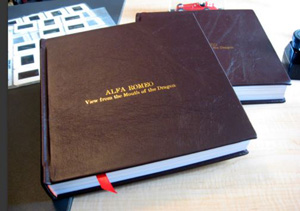 Alfa Romeo: View from the Mouth of the Dragon by S. Scott Callan
Alfa Romeo: View from the Mouth of the Dragon by S. Scott Callan
A Velocity Group publication
Hardback, leather bound, 369 pages
34 engineering illustrations 30 illustrations of Alfa Romeos,
56 color photographs, and film frames of the races between the wars.
Order via http://www.gearshift.com/library/TheNewBook.html
Price, $395 USD plus shipping
Review by Pete Vack
Take two luxurious leather covers, add a masterful binding and between those physical constraints, one can let the imagination soar. For a book can be many things, free from formal rules, modified to create a theme or idea or concept, a technical dissertation or a work of art or both at the same time. When reviewing a book such as this, one needs to allow the author to capture that promise of imagination.
Alfa Romeo: View from the Mouth of the Dragon is not only a unique reading experience, but also a book that is custom made on its own press run and hand bound in leather. The name of the person for whom it is made is on the title page. Each book is numbered, dated and signed by the author and illustrator. Each takes about six weeks to produce.
Yet this Gutenberg Bible-like book was developed from a now-defunct computer technology which showed great promise—back in 1993.
Reverse Technology
Due to the computer revolution, in the 1990s, there were more opportunities than ever before to produce something different in the way of books – for example a book with animation via a CD. No one was more interested in the new technology than writer and documentary producer S. Scott Callan. Following development of an automotive TV series with Time Warner, Callan set about to produce a new type of automotive publication that combined the text of a book with the film, sound and animation of a TV production.
He found archival films from the 1920s and 30s, and included them in his animated book as well as superb moving drawings of Alfa Romeo engines in cutaways. There were sounds, interviews, and the project was more like a documentary than a book. Indeed, Callan was on the leading edge of the emerging hi tech computerized desktop publishing industry. In 1997, James Elliot writing in Classic and Sportscars, wrote:
“Make no mistake, this hi-tech CD-ROM is actually a book. Alfa Romeo: View from the Mouth of the Dragon comes from the States and traces the history of Alfa from its Darracq roots and through all the great characters such as Ferrari, Jano and Merosi. To use the book you need a PC running Windows and-be warned-it does take a little getting used to reading a book on a computer screen. On the plus side S Scott Callan and Kip Crosby’s book is an absorbing read and the big advantages of all this technology are motion sequences and sub files on the more important figures. An excellent 500-page ‘living archive’ as fascinating as it is encyclopedic.”
Note the keyword “CD ROM” or compact disc with Read Only Memory. You remember those, don’t you?
The problem was that technology changed, industry standards changed, as well as hardware; in effect, CD ROM technology and software is as outdated as the Beta video tape cartridge. What’s more, though it can be done, there is no effective way to convert CD ROM to the current DVD technology.
Not wanting the CD to pass into history, in 2013 Callan looked at producing a new print edition. He basically started from scratch. Five more years were added to the history, extending it to the beginning of WWII. A whole new series of engineering illustrations were produced in place of the CD’s engine animations. Its 500 ‘electric’ pages were transformed into print. These were to be a finely produced, one at a time, leather bound top quality books in every respect. In other words, reverse technology.
More Gutenberg than Google
This kind of production didn’t make it easy for reviewers to get a copy for review. He sent along a PDF, which works great, but the essence and cost of the real book simply wasn’t there. Nothing like the smell and feel of a top grade leather cover superbly stitched binding and sumptuous 80 lb matte paper. As far as PDFs go, (or their close relation e Books) they are easy to read but mygosh we all spent far too much time in front of an electronic screen and reading a printed book now becomes a much needed escape from the workstation.
And so it was that there we were, sitting on the couch, reading a very finely produced almost biblical in nature product that was more Gutenberg than Google. And a good thing, too, as the book is almost a work of art, a musical assembly of evocative images and words that capture the essence of Alfa Romeo from the Darracq beginnings to the last of the Jano cars in 1939. Perhaps there is no better means of experiencing the difference – and what is lost – between the traditional printed media and screen reading. (There are many books on the subject but we’ll not go there here).
Why this Alfa book is different
There are a great number of books on Alfa. But as Callan found, none really provide an overall look at the various activities of the company and include the cars, races, factory history, tech details and accomplishments. And basically, he is right. What he then set out to achieve is a compendium that tells the tale in a friendly manner, using race results, car specs, factors affecting the operations at Alfa such as the Darracq years, Fiat’s withdrawal from racing, the government takeover and the ensuing concentration on air power in the years before WWII and discussions that include a close look at the competition. Combine Patrick Italiano with Ken Purdy and Peter Hull and you have an idea of what lies between those leather bound covers. Callan’s style is informative yet informal, and he creates a sense of history and passion without getting the reader bored with details. A note here about the chapters on racing; they cover the major events and do so with accuracy, but the font for the racing chapters is a type of script that is a bit hard to read; it sets off the racing sections but not as enjoyable to read. Read a PDF chapter from the book on the 1925 Belgian Grand Prix.
Getting the reader involved
One of Callan’s objectives was to engage the reader in a variety of ways, to use what is presented as an incentive to look further. And we must admit, this worked. Because of the manner in which the engine drawings were represented, I spotted something about the 6C 1750 that I had not previously noticed or thought about; how the water and fuel pump were driven from the rear mounted cam drive. This was puzzling, so I hit the well-known Alfa books only to find that none properly described the water pump and presumably oil pump operation. I’m still not sure about the oil pump (and the round object on the left of the cross shaft is the generator, but Callan’s illustrations certainly begged the question. His comment on the 1750 Gran Turismo reminded me that indeed, it was Alfa that originally used the term Gran Turismo as a model name, not Lancia.
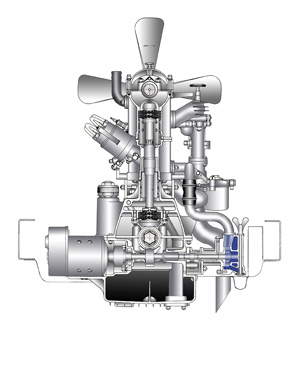
Cross section of the 6C1750 with the cross shaft driving the water pump on the right and generator on the left.
As mentioned, each volume is produced as ordered, and hand assembled. This ensures quality, yet increases the cost. On the other hand, Callan can change the text and images with each book, catching, errors, improving quality, changes images as he deems necessary, more or less like Ettore Bugatti might have done with the production of Bugattis at Molsheim. Hence, the early copy I received may be different than the one you order and he is now even changing the color of the leather per a suggestion of Alfa owner Alain de Cadenet to a deep dark red that reflects the color of the race cars of the 1930s.
And so we asked
Since this is a very different type of book, it requires some thought, and a few of our questions were directed back to the author.
We found that some of the images as printed are a bit blurry. So we asked Callan about that. “With over four decades experience in all of this, it was all very intentional. I wanted it to look like a book that had been printed during the 1930s.” said Callan. However, whatever the intent, the digital revolution has in the meantime increased reader’s expectations of photo quality.
There is no bibliography or index as such. At the end of the book is an unusual set of chapters entitled “Index” that serve to highlight some segments of Alfa history. Since this was a bit different than the normal book structure, we asked Callan to elucidate. “To create the Alfa CD I had to create a new form a literature. I transformed the traditional linear plot structure of books and film, to a multi-threaded, navigable plot structure, which allowed me to present several stories simultaneously, yet sequentially. I named the literary format E-Lit. At the heart of this was the ‘Core Story’ from which you navigated to the selected parallel stories, then returned to the Core Story. Here [in book format], rather than presenting the Core Story at the front end of the book, with an ability to proceed to the individual chapters through page notation, I chose to use the Core Story as the index, and present the chapters in historical timeline, the chapters often referring to the core story or index, and the index referring directly back to the chapters.”
Read a PDF chapter from the book about the Alfa 6C 1500.
We thought it would be a nice idea to use those racing clips that were part of the original CD and package a disc or thumb drive with the book. Callan responded, “I do require my readers to use their imagination through the examination of the individual film frames presented to tell those stories. Once again, I am triggering intellectual and aesthetic activity in the context of the written story presented. To merely package a view able film of such would be far too out of context for my purposes here. That format would be for a wholly orchestrated digital or broadcast production.”
Still, a thumb drive that would accompany the leather bound volume would be nice, for there are great video images that while printed in the book, would go a long way to describe the early racing victories. We searched for the same film clips on YouTube, but failed to find many of them, in particular the all-important 1924 French Grand Prix.
We enjoyed the sizing of the book, a square format of 8.5 by 8.5 inches and is large enough to present the art while not being too large and heavy to enjoy. The bruised thighs that result from other hefty books are not a problem in this case.
View from the Mouth of the Dragon is a necessary work; nothing quite like this exists and the subject begs the product. The style, comprehensive history, and informative art and drawings and the high quality of the book itself are most impressive. If it is meant to challenge the mind and imagination, it does. And we hope it is only Volume 1; it would be great to see Volume 2 cover the years from 1945 to 1989.
Note: Alfa Romeo, A View from the Mouth of the Dragon is paying advertiser on VeloceToday.
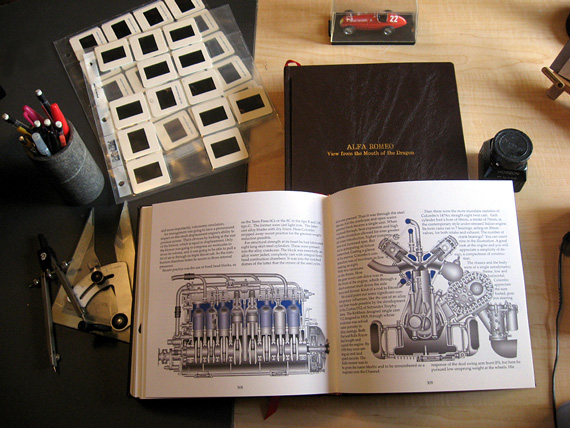
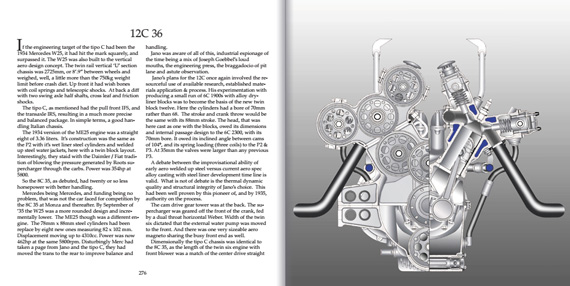
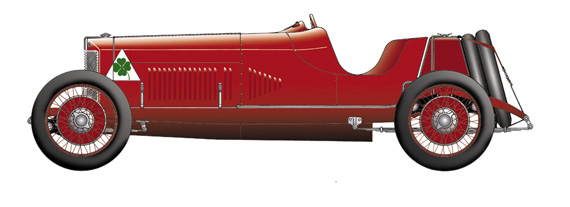
I had a look at the pdf chapters and found them disappointing.Plenty of spelling mistakes (it’s = IT IS,could the planet please note this),misspelt names and a very matey tone (trans,Lindy) that doesn’t suit the seriousness of the subject at all.Sometimes the reader gets the impression the text is a poor translation (pull front IFS) and many sentences need reading at least twice.The illustrations are very well done though and I’m sure the research was thorough but the proofreading stage seems to have been skipped altogether.I’ll stick with Simon Moore.
Michel Van Peel
I have to second Michel van Peel’s comments. This book must stand on the illustrations almost alone. The translation, which is obvious, is clumsy at best. And finally, the cover price is, well, let the purchaser decide that.
While I haven’t seen this book myself, I just wanted to say that in general, translation of technical material is difficult at best and should be vetted by someone technically skilled in the subject matter, in both languages and in the specific art of translation (which is more than mere transliteration).
Jim F
I had chosen the 12C 36 chapter to link off of Pete’s review for a number of reasons.
In the beginning it discusses the much overlooked fact that the so often spoken of supremacy of the pre-war ‘silver arrows’ Mercedes team was not so dominant that year. As a matter of fact the cars were dogs, barley able to get out of their own way. Clearly illustrating that the competition was very much between Alfa and Auto Union. The sub-plots here being, team management and finance were Alfa’s greatest impediment during an ascendant year, on the one hand, and the failure of the Nazi-backed racing-by-committee operation that was the Mercedes GP effort, on the other. Which resulted in the latter being restructured under the engineering direction of Uhlenhaut and closely managed by Neubauer. A structure that was to survive the War.
This chapter also addressed, in some detail, an evolution of engineering at Alfa that was to live on after the war as well, under the heraldic of the team manager. Foreshadowing the reunion of Jano and Ferrari some twenty years later.
Also covered is the post-depression resurrection of road racing in the U.S. Laying, as it did, a foundation of racing beyond the oval after the war and to this day. All under the guise of taking the time to tell the story of the Vanderbilt races in detail and period color.
The 12C 36 chapter also goes into how the true impact of the ‘junk formula’ was the formation of the seminal Offenhauser operation from the remains of Harry Miller’s penultimate racing organization, and genius.
All in engineering detail and political context far beyond previous publications.
Taken as a whole this chapter was composed to look back and, as stated, foreshadow post war events. As such, I thought it would be a good choice to provide insight into the many dimensions of the Alfa book.
My purpose in writing this for the comments section? Well, perhaps to express that I can understand how the conversational prose style I crafted for this book may not be easily understood by reading just one chapter. Just as holding one wedged stone doesn’t fully define an arch. And since I am responsible for every aspect of my books, from photography and artwork, to design and production of galley, I do have a bad habit of writing right into the galley occasionally, not a good idea since I never seem to spell recieve correctly…and yes, there have been those who have said the humour undermines the veracity of what’s stated. Well, being an Italian who’s been in the Peninsula’s motor industry, I can assure you, we’re a pretty sarcastic bunch. Humour and enthusiasm do kind of drive the operation, matey.
Perhaps though its, oh excuse me – it’s best someone else addresses this: “…But there is ‘something completely different’ (as Monty Python used to say) in your books with regard to most automobilia books: The contents and how the stories are narrated. The way your writing introduces the reader to your tale with some humor and irony that makes the reader appreciate even more the enormous amount of inquiry and research that includes, is for me the most valuable component, as should be for any book, independent of presentation.” Aresio, an MD & PhD in Madrid, probably did the translation here on the fly while writing this about his editions of the Alfa book and Metal Memory.
Yes, I know, Dante long ago identified responding to comments on the internet as an entrance to one of the circles of hell…quod est dicere, de gustibus non est disputandum,
The author, illustrator, photographer, art director & publisher
Dear S. Scott Callan,
my beef was not with your choice of chapter but with your prose and the tone the chapter is set in.You are simply cramming too much information into each sentence.
The text reminds me of a prospectus for an Italian art fair,same pompous language and verbosity.What took the biscuit for me though is that you call von Brauchitsch
“von Bratwurst”.That I found hard to swallow.
I rest my case.
Michel Van Peel